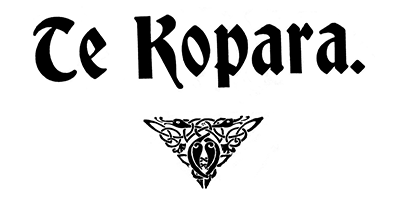
Kopara
Available issues
Background
I whāia mai Te Pīpīwharauroa e Te Kōpara (The Bell Bird, 1913-1921) engari e aro nui ana ki ngā mahi a te Hāhi. I kapia Te Kōpara e Te Toa Takitini. I tuhia tēnei pepa ki te reo Māori.
I mihia Te Pīpīwharauroa i roto i te pānui etita tuatahi:
He tangi atu tēnā, he maimai aroha ki tā koutou manu, ki te Pīpīwharauroa, ka mutu nei tōna hokihoki ki te toro mai i ngā wāhi katoa o Aotearoa nei, o Te Waipounamu, o Rangiura, o Wharekauri. Ka maha nei ōna tau i rere mai ai i tōna whenua tawhiti me te puta tonu o tana karanga, 'Kūi, kūi, kūi, whiti, whitiora' (Oketopa, 1913: 1)
I te wā i whakamutua Te Pīpīwharauroa i runga i ngā raru ā-pūtea, i whakatūria e te Pīhopatanga o Waiapu o te Hāhi Mihinare ko Te Kōpara. He mea etita e Wī Paraire Rangihuna o Ngāti Porou.
Mā ngā whakataukī e rua i puta te huatau a te etita ka kawea e te niupepa iti nei Te Kōpara ngā pānui whai take anake:
- Tērā pea koutou e haku ki te iti o taku rourou, me te mea ko 'te rourou iti a Haere'. Otirā he hinu anake te kai o taku rourou. ....
- Tētahi kī anō ā mua, 'Ruia taitea, kia tū ko taikākā anake' (taua puka anō: 2).
I puta hoki te koronga o te niupepa i taua pānui etita tonu:
Āku e kohi ai ki taku rourou, ko ngā mea pakari, ko ngā mea e tupu pai ai te tangata i runga i te whakaaro ki te Atua e whakawhiwhi nei i a tātou ki ngā mea katoa e ora ai te wairua me te tinana (taua puka anō.)
I aro atu te nuinga o ngā kaupapa ki ngā mahi a te Hāhi Mihinare me ngā whakamārama o ngā karaipiture.
E hiahia ana te Puna Mātauranga o Aotearoa ki te mihi ki a Gail Dallimore mōna i tuku kōrero mai i whakamahia i roto i ngā tuhinga roa mō ngā niupepa Māori.
Te Kopara (The Bell Bird, 1913-1921) continues Te Pipiwharauroa but is concerned mostly with Church activities. Te Kopara was superseded by Te Toa Takitini. This paper is written in Māori.
The opening editorial acknowledged Te Pipiwharauroa:
- He tangi atu tena, he maimai aroha ki ta koutou manu, ki te Pipiwharauroa, ka mutu nei tona hokihoki ki te toro mai i ngā wāhi katoa wahi katoa o Aotearoa nei, o Te Waipounamu, o Rangiura, o Wharekauri. Ka maha nei ona tau i rere mai ai i tona whenua tawhiti me te puta tonu o tana karanga, 'Kui, kui, kui, whiti, whitiora' (October, 1913: 1)
- [This is a lament, a token of affection for your bird, Te Pipiwharauroa, who no longer returns to visit the North and South Islands, Stewart Island and the Chathams. For so many years she has flown here from her distant home calling continually, 'Kui, kui, kui, whiti, whitiora'].
When Te Pipiwharauroa folded due to financial difficulties, the Waiapu Diocese of the Church of England established Te Kopara. It was edited by Wi Paraire Rangihuna of Ngāti Porou.
Through two whakatauki, the editor suggested that the smaller newspaper Te Kopara would carry only the most essential items:
- Tera pea koutou e haku ki te iti o taku rourou, me te mea ko 'te rourou iti a Haere'. Otira he hinu anake te kai o taku rourou. ....
- Tetahi ki ano a mua, 'Ruia taitea, kia tu ko taikaka anake' (ibid. : 2).
- [You may complain of my smallbasket - for it is like the 'small basket of the constant traveller'. Take note that my basket holds only the best food (birds preserved in their own fat)....
- There is another saying of old, 'Strip the sapwood, so that only the heartwood stands clear'].
The intention of the newspaper was summed up in the same editorial:
- Aku e kohi ai ki taku rourou, ko nga mea pakari, ko nga mea e tupu pai ai te tangata i runga i te whakaaro ki te Atua e whakawhiwhi nei i a tatou ki nga mea katoa e ora ai wairua me te tinana (ibid.)
- [What I shall gather in my food basket are those things that will strengthen people in their belief of God who gives us everything for our spiritual and physical well-being].
The subjects covered mostly concern Anglican Church activities and explanations of tracts of scripture.
The National Library would like to thank Gail Dallimore for providing information used in essays about Maori newspapers.
Copyright statement
See our copyright guide for information on how you may use this title.
Acknowledgements
E hiahia ana Te Puna Mātauranga o Aotearoa ki te whakamoemiti ki te Department of Computer Science, University of Waikato, mō rātou i āwhina i te whakamamatitanga o tēnei taitara.
The National Library would like to thank the Department of Computer Science, University of Waikato for their assistance in the digitisation of this title.
 Log in
Log in